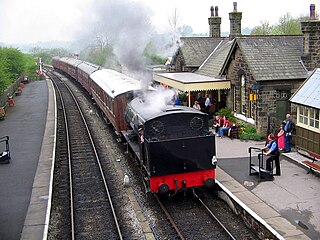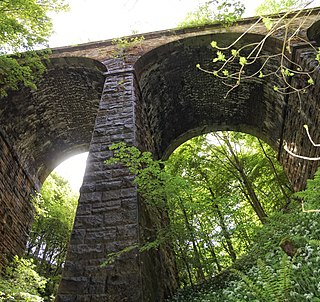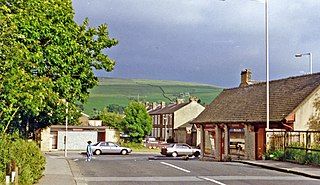
The Embsay and Bolton Abbey Steam Railway (E&BASR) is a heritage railway in North Yorkshire, England, formed in 1979 and opened in 1981.

Grassington is a village and civil parish in North Yorkshire, England. The population of the parish at the 2011 Census was 1,126. Historically part of the West Riding of Yorkshire, and now in the lieutenancy area of North Yorkshire, the village is situated in Wharfedale, about 8 miles (10 km) north-west from Bolton Abbey, and is surrounded by limestone scenery. Nearby villages include Linton, Threshfield, Hebden, Conistone and Kilnsey.

The Wharfedale line is one of the rail services in the West Yorkshire Metro area of northern England. The service connects Ilkley with Leeds and Bradford, and is operated by Northern Trains. West Yorkshire Metrocards are available for use on the line, covering Zones 3–5. The line is served predominantly by four-coach Class 333 electric multiple units.
The North Western Railway (NWR) was an early British railway company in the north-west of England. It was commonly known as the "Little" North Western Railway, to distinguish it from the larger London and North Western Railway (LNWR).

Colne railway station serves the town of Colne, in Lancashire, England, which is situated close to Pendle Hill. The station, which is managed by Northern, is the eastern terminus of the East Lancashire Line. Trains from Blackpool South run through Preston and Blackburn to Burnley and Colne.

Menston railway station serves Menston in the City of Bradford, West Yorkshire, England. On the Wharfedale Line between Ilkley and Leeds/Bradford Forster Square, it is served by Class 331 and 333 electric trains run by Northern Trains, who also manage the station.

Ilkley railway station serves Ilkley in the City of Bradford, West Yorkshire, England. On the Wharfedale Line, it is served by Class 333 electric trains run by Northern Trains, which also manages the station.

Skipton railway station is a Grade II listed station which serves the market town of Skipton in North Yorkshire, England on the Airedale Line, which gives Skipton access to destinations such as Leeds, Bradford, Carlisle, Lancaster and Morecambe. The station is operated by Northern Trains and is situated 27 miles (43 km) north-west of Leeds.
The Leeds and Bradford Railway Company (L&BR) opened a railway line between the towns on 1 July 1846. It extended its line from Shipley through Keighley to Skipton and Colne, in 1847 and 1848.
The Preston and Longridge Railway (P&LR) was a branch line in Lancashire, England. Originally designed to carry quarried stone in horse-drawn wagons, it became part of an ambitious plan to link the Lancashire coast to the heart of Yorkshire. The ambition was never achieved, but the line continued to carry passengers until 1930 and goods until 1967.

Grassington & Threshfield railway station was a railway station that served the town of Grassington and village of Threshfield, in North Yorkshire, England.
The Forge Valley Line was a 16-mile-long branch of the North Eastern Railway between Seamer and Pickering in North Yorkshire, England. The line was intended to link Scarborough with Pickering. It opened in 1882 and closed in 1950, with the exception of a stretch from Pickering to Thornton Dale which remained open for quarry traffic until 1963.

Embsay railway station is a railway station on the Embsay and Bolton Abbey Steam Railway. It serves the small village of Embsay in North Yorkshire, England. The station is a terminus on the railway and was re-opened in 1981.

The Skipton–Ilkley line is the route that the Midland Railway took to link the towns of Skipton and Ilkley via the villages of Embsay, Bolton Abbey and Addingham.

Rylstone railway station was a railway station that served the small village of Rylstone in North Yorkshire, England. It was built by the Yorkshire Dales Railway and operated by the Midland Railway. The station opened on 29 July 1902 with a station building that was to the same design as most of the stations on the Derwent Valley Light Railway.

Swinden Quarry is 0.62 miles (1 km) north of the village of Cracoe, and 1.9 miles (3 km) south-west of Grassington in North Yorkshire, England. It is owned by LaFarge Tarmac. The former Skipton-Grassington railway line still serves this location, and in railway terminology, the site is known as Rylstone Quarry.

Earby railway station was a junction station that served the town of Earby, in the West Riding of Yorkshire, England. Since 1974 Earby is within the boundaries of the administrative county of Lancashire. The station was built by the Midland Railway, on the former Leeds and Bradford Extension Railway between Skipton and Colne and opened in 1848.

The Leeds and Bradford Extension Railway was an early British railway company in the West Riding of Yorkshire. It built a line from Shipley near Bradford through Keighley and Skipton to Colne. The Skipton–Colne Line closed in 1970, but the remainder of the line is still in use today, and once formed part of the Midland Railway's main line route from London to Glasgow.

The Otley and Ilkley Joint Railway was a railway line running between the towns of Otley and Ilkley in West Yorkshire. The line was managed and run jointly by the Midland Railway (MR) and the North Eastern Railway (NER) and was 6+1⁄2 miles (10 km) long. Opened to passenger traffic on 1 August 1865 and freight traffic some months later, the line ran for almost 100 years before partial closure in July 1965 when the line to Otley closed. Today passenger services run over the rest of the line as part of the West Yorkshire Passenger Transport Executive (WYPTE) Wharfedale Line.

Skirethorns is a hamlet in Wharfedale, North Yorkshire, England. The hamlet is just west of the village of Threshfield, in the Yorkshire Dales National Park, some 6 miles (9.7 km) south of Kettlewell, and 8 miles (13 km) north of Skipton. Threshfield Quarry is located north-west of the hamlet, and despite its name, it is located in Skirethorns.

















